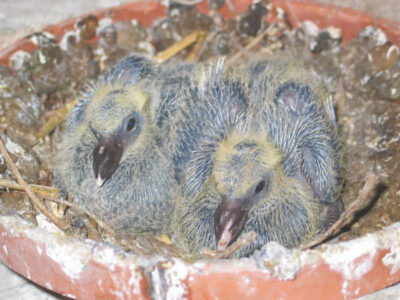Learn how to train homing pigeons and discover the fascinating history of their use in war and peace time.
My brother and I have been pigeon fanciers for over 50 years, exporting and importing the birds and winning major races with them in the United States and Japan. Most people are unaware of the sport, and the impact pigeons have had throughout history. But raising and training these birds can be an affordable hobby, and a unique pastime for all members of your family.
Homing pigeons are a type of domestic pigeon that’s been bred for speed and homing instinct. A trained homing pigeon will return to its loft when released from a distant location. They’ll consider your loft their home for life, and will risk their lives to return to it. The typical lifespan of these birds is 10 to 20 years. They don’t bark, bite, or scratch, and can become excellent companions for their human trainers. Homing pigeons and doves are both members of the Columbidae family.

Homing pigeons through history
Pigeons have shaped political and commercial empires, and saved lives in war and peacetime. The practice of using homing pigeons for communication was first recorded in Egypt and Mesopotamia as early as 3000 B.C. Mongol leader Genghis Khan established a postal system that used homing pigeons to transport messages across Asia in the early 13th century. The Reuters news agency got its start in 1849 by using pigeons to relay advance notice of stock market prices. Until the invention of the telegraph in the mid-1800s, homing pigeons were the best message carrier — reliable and fast, capable of traveling nonstop for 12 to 15 hours at average speeds of 40 to 60 miles per hour. They traversed deserts, jungles, oceans, and mountains at altitudes of 6,000 feet or more. A pigeon’s wings can beat up to 10 times per second, and the birds can maintain a heart rate of up to 600 beats per minute for hours without rest.
How to train homing pigeons
Nesting and mating
A pigeon only needs a couple of tablespoons of whole grain a day, along with some inexpensive grit, fresh drinking water, and simple shelter from weather and predators. A homemade loft as small as 8 by 7 feet can house up to two dozen pigeons. My first loft was made up of a small converted pigpen for the enclosure and a rabbit hutch for the shelter.

Pigeons are monogamous by nature. Unless forcibly separated, a cock usually will keep the same mate and nest throughout his lifetime. You’ll need to provide each mated pair with its own nesting area or compartment. You can optionally outfit the area with a nesting bowl that’s lined with short pieces of straw or handfuls of pine needles. The inexpensive plastic pet feeding bowls available at discount stores (9 to 10 inches in diameter) will make excellent pigeon nests.
If left unattended, pigeons can mate as young as 4 months old, but, for breeding purposes, mating shouldn’t be permitted until the birds are 1 year old and fully mature. After the cock and hen are brought together and the nest is built, the cock will begin to drive the hen toward the nest with frequent pecking. The first egg will be laid between 5 and 10 days after nesting has started, and the second egg will be laid the following day. Then, the cock and hen will take turns sitting on the eggs. The incubation period is about 17 days.
Squabs and squeakers
Newly hatched pigeons are called “squeakers,” and are covered with yellow down. Their feathers will begin to come in after about 10 days, and then you’ll know the bird’s color. For the first 2 weeks they’re fed regurgitated curd or “crop milk” by the parents, who force the food up into the youngster’s throat with a pumping motion.

Homing pigeon enthusiasts will band young birds, known as “squabs,” when they’re 1 week old. Banding offers lifelong identification.
Banding and registration
You should register your pigeons, because the serial numbers on the bands can be traced back to you if the birds stray or are stolen. Banding must be done before the feet have grown too large to permit the band being slipped over the toes. To place a band, you stretch the toes out in a straight line, with the rear toe facing backward and the three front toes pointing forward and pressed close together. The ring-shaped bands are seamless and made of aluminum or plastic; they can be purchased from pigeon supply companies. The band will be stamped with a serial number and letters indicating the owner’s club affiliation (for example, NPA for National Pigeon Association). The clubs maintain databases that correlate the number to the owner.
Training to home
When a pigeon is 28 days old, you’ll wean it by moving the bird to another part of the loft, thereby separating it from its parents. In the following weeks, you’ll train it to “home” to the loft by releasing it from outside the loft entrance when it’s hungry. During all training, hunger is the incentive and food is the reward. To eat, the young bird will have to enter the loft from outside, and fly through the one-way opening known as the “trap.” The pigeon will return to the loft by landing on a shelf called the “landing board,” then pass through the trap, enter the loft, and proceed to its perch.

Gradually during the course of the multi-week training period, you’ll release the young pigeon from points farther and farther away from the loft entrance, and from a variety of locations. This trains the bird to fly home from any release point. The homing instinct is established at about 8 weeks. After that time, the young pigeon can be relocated to a new loft, but it will still return to the loft it’s been homed to.
Pedigreed homing pigeons can be purchased for under $100, although established bloodlines can be quite costly. We recommend Stromberg’s as a reliable source of pigeons. The company also sells loft supplies and can help you get started.
Read more on raising birds:
- Reasons for Raising Ducks at Home
- Keeping Geese: From Gosling to Goose
- Our View: Feed the Birds
- Growing and Making a Gourd Birdhouse
Lye Miller is a veterinarian who shares a lifelong interest in homing pigeons with his brother, Thayer Keith Miller. More information on homing pigeons can be found in the latter’s book Racing Pigeons: A Manual.







